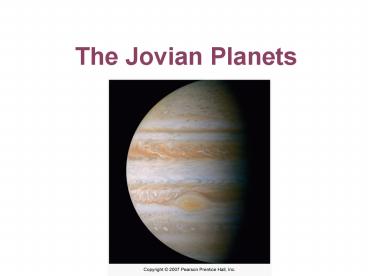The Jovian Planets - PowerPoint PPT Presentation
1 / 27
Title:
The Jovian Planets
Description:
Jupiter can be imaged well from Earth, even with a small telescope ... Jupiter and Saturn were known to the ancients; Uranus was discovered by chance, ... – PowerPoint PPT presentation
Number of Views:129
Avg rating:3.0/5.0
Title: The Jovian Planets
1
The Jovian Planets
2
7.1 Observations of Jupiter and Saturn
Jupiter can be imaged well from Earth, even with
a small telescope Here Jupiter with its Galilean
moons
3
7.1 Observations of Jupiter and Saturn
True color image of Jupiter
4
7.1 Observations of Jupiter and Saturn
Natural-color image of Saturn
5
7.2 The Discoveries of Uranus and Neptune
Uranus, in natural color. Note the absence of
features.
6
7.2 The Discoveries of Uranus and Neptune
Neptune in natural color
7
7.3 Bulk Properties of the Jovian Planets
The Jovian planets are large and much less dense
than the terrestrial planets Saturn is less
dense than water!
8
7.3 Bulk Properties of the Jovian Planets
Jovian planets, compared to Earth
9
7.3 Bulk Properties of the Jovian Planets
Peculiarity of Uranus axis of rotation lies
almost in the plane of its orbit. Seasonal
variations are extreme.
10
7.4 Jupiters Atmosphere
Atmosphere has bright zones and dark belts Zones
are cooler, and are higher than belts Stable flow
underlies zones and bands, called zonal
flow Simplified model
11
7.4 Jupiters Atmosphere
No solid surface take top of troposphere to be 0
km Lowest cloud layer cannot be seen by optical
telescopes Measurements by Galileo probe show
high wind speeds even at great depth probably
due to heating from planet, not from Sun
12
7.4 Jupiters Atmosphere
Major visible features Bands of clouds Great
Red Spot
13
7.4 Jupiters Atmosphere
Lightning-like flashes have been seen also
shorter-lived rotating storms One example Brown
Oval, really a large gap in clouds
14
7.5 The Atmospheres of the Outer Jovian Worlds
The atmosphere of Saturn is similar to that of
Jupiter, except that Saturn is somewhat colder
and its atmosphere is thicker.
15
7.5 The Atmospheres of the Outer Jovian Worlds
Saturns atmosphere is similar to Jupiters,
except pressure is lower Three cloud layers Cloud
layers are thicker than Jupiters see only top
layer
16
7.5 The Atmospheres of the Outer Jovian Worlds
Jupiter-style spots rare on Saturn dont form
often and quickly dissipate if they do
17
7.5 The Atmospheres of the Outer Jovian Worlds
Storms near Saturns equator
18
7.5 The Atmospheres of the Outer Jovian Worlds
Dragon storm on Saturn apparently a vast
thunderstorm
19
7.5 The Atmospheres of the Outer Jovian Worlds
Rotation of Uranus can be measured by watching
storms
20
7.5 The Atmospheres of the Outer Jovian Worlds
Neptune has storm systems similar to those on
Jupiter, but fewer. The large storm system at top
has disappeared in recent years
21
7.6 Jovian Interiors
No direct information is available about
Jupiters interior, but its main components,
hydrogen and helium, are quite well understood.
The central portion is thought to be a rocky core.
22
7.6 Jovian Interiors
Magnetic fields of Uranus and Neptune must not be
produced by dynamos, as the other planets fields
are Interior structure of Uranus and Neptune,
compared to that of Jupiter and Saturn
23
7.6 Jovian Interiors
Jupiters magnetosphere Intrinsic field strength
is 20,000 times that of Earth Magnetosphere can
extend beyond the orbit of Saturn
24
7.6 Jovian Interiors
Aurorae are seen on Jupiter, and have the same
cause as those on Earth the interaction of
solar wind particles with the magnetosphere
25
7.6 Jovian Interiors
Uranus and Neptune both have substantial magnetic
fields, but at a large angle to their rotation
axes.
The rectangle within each planet shows a bar
magnet that would produce a similar field. Note
that both Uranuss and Neptunes are
significantly off center.
26
Summary of Chapter 7
- Jupiter and Saturn were known to the ancients
Uranus was discovered by chance, and Neptune was
predicted from anomalies in the orbit of Uranus - Jovian planets are large but not dense they are
fluid and display differential rotation - Cloud layers have light zones and dark bands
wind pattern, called zonal flow, is stable
27
Summary of Chapter 7
- Storms appear with regularity the Great Red
Spot of Jupiter has lasted for hundreds of years
(that we know of) - Due to conductive interiors and rapid rotation,
Jovian planets have large magnetic fields - Jupiter, Saturn, and Neptune radiate more energy
than they receive from the Sun































